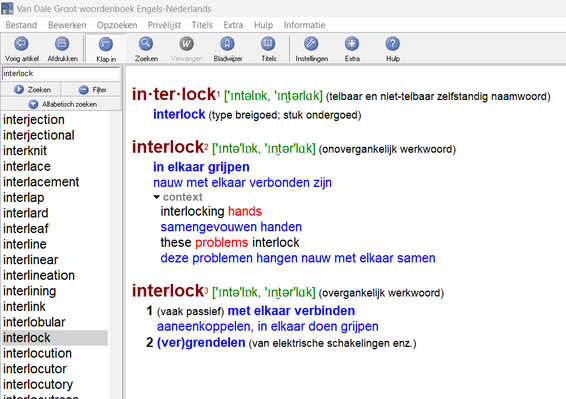
English
- interlocking mechanism
Dutch
- vergrendelingsinrichting
- grendelmechanisme
- vergrendelinrichting
External links
- https://en.wikipedia.org/wiki/Interlock_(engineering)
- https://en.wikipedia.org/wiki/Interlocking[1] ⇄ https://nl.wikipedia.org/wiki/Rijwegbeveiliging[2]
References
- ↑ In railway signalling, an interlocking is an arrangement of signal apparatus that prevents conflicting movements through an arrangement of tracks such as junctions or crossings. In North America, a set of signalling appliances and tracks interlocked together are sometimes collectively referred to as an interlocking plant or just as an interlocking. An interlocking system is designed so that it is impossible to display a signal to proceed unless the route to be used is proven safe. Interlocking is a safety measure designed to prevent signals and points/switches from being changed in an improper sequence. For example, interlocking would prevent a signal from being changed to indicate a diverging route, unless the corresponding points/switches had been changed first. In North America, the official railroad definition of interlocking is: "An arrangement of signals and signal appliances so interconnected that their movements must succeed each other in proper sequence". (https://en.wikipedia.org/wiki/Interlocking)
- ↑ Rijwegbeveiliging, rijwegvergrendeling of interlocking zijn vormen van spoorwegbeveiliging. Een andere aanduiding is stationsbeveiliging. Rijwegbeveiliging sluit conflicterende treinbewegingen uit. Een rijwegbeveiliging verhindert dat een spoorwegsein op veilig gezet kan worden zolang niet gegarandeerd is dat de rijweg na dat sein veilig is. Als de rijweg veilig is wordt hij vastgelegd. Dan zijn alle wissels in de rijweg vergrendeld. Dat geldt ook voor de seinen die de toegang tot de rijweg "bewaken". Er kunnen dan geen rijwegen ingesteld worden die conflicteren met een vergrendelde rijweg. De rijweg kan pas worden vrijgegeven als de trein is gepasseerd, of na specifieke veiligheidshandelingen. Die laatste zijn bijvoorbeeld nodig als een trein stil valt. (https://nl.wikipedia.org/wiki/Rijwegbeveiliging)